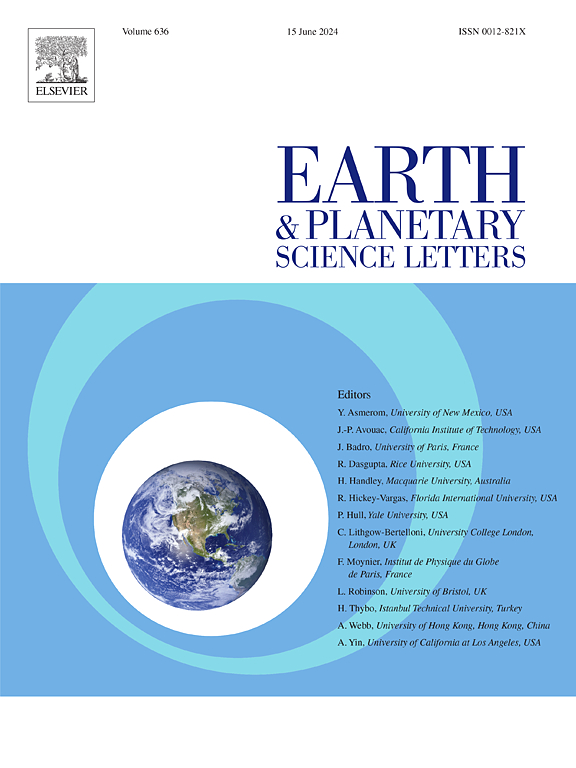Decoding the interplay between magma thermodynamics and lithospheric thermal state as a possible explanation for the origin of the Daly Gap
IF 4.8
1区 地球科学
Q1 GEOCHEMISTRY & GEOPHYSICS
引用次数: 0
Abstract
The mechanisms responsible for determining whether a magmatic system will generate a bimodal or monotonous intermediate volcanic suite are still widely debated in igneous petrology. Thus, the compositional characteristics of volcanic suites represent the ultimate reflection of their magmatic evolution and provide crucial insights into their remote volcanic and igneous plumbing systems. Decoding what these erupted compositions record is challenging however, and of paramount importance for volcanology, igneous petrology, and tectonic studies. This work employs an integrated petrological and thermal numerical modeling approach to identify the variables that modulate the compositional diversity registered in several volcano-tectonic settings, using two Neoproterozoic extensional rift basins in southern Brazil as case studies. Based on rhyolite-MELTS thermodynamic models of fractional crystallization, the resulting crystallization-differentiation curves of basaltic magmas indicate that the prevalence or scarcity of intermediate compositions in the volcanic record results from the thermodynamic control of differentiation patterns, whereas the numerical models also support the interplay with lithospheric heat transfer/maintenance processes. There is a well-known, yet underexplored, tendency of fractionating basaltic magmas to differentiate rapidly through intermediate compositions, possibly associated with a sudden increase in silica contents owing to Fe-Ti oxides crystallization and/or crystal productivity. This may explain the lack or scarcity of these compositions within predominantly bimodal volcanic suites, an observation known as the Daly Gap. The models presented in this contribution explore the nonlinear dependency between composition, crystallinity, and temperature (X-F-T) of differentiating basaltic magmas, which seems to be a common feature shared by alkaline, transitional, and even sub-alkaline basalts. When accounting for the considered thermic state of the medium they intrude into (ca. 300 to 800 °C) and the modeled accretion rates (ca. 0.01770 to 0.00354 m/yr) for intervals ≤ 300 ka, the models reveal that magma reservoirs undergoing crystallization-differentiation can only store intermediate compositions capable of erupting in relatively warm environments. Conversely, magma reservoirs with lower heat accumulation consist of alternating basic and silicic compositions, potentially giving rise to bimodal volcanic sequences. In these systems, compositional gaps are associated with increased crystal productivity over limited temperature intervals in the X-F-T space, coupled with relatively lower degrees of heat accumulation. Additionally, a subordinate compositional gap has been observed in the modeled silicic magmas, supporting our interpretation that increased crystal productivity results in subdued compositions along continuous liquid lines of descent. These nonlinear crystallization-fractionation patterns of basalts can also contribute to the compositional disparity between the volcanic and plutonic realms at arc settings.
解码岩浆热力学与岩石圈热状态之间的相互作用,作为对戴利沟起源的一种可能解释
火成岩岩石学对决定岩浆系统产生双峰还是单峰中间火山岩套的机制仍存在广泛争议。因此,火山岩套的成分特征代表了其岩浆演化的最终反映,并为了解其遥远的火山和火成岩管道系统提供了重要信息。然而,解码这些喷发成分所记录的内容具有挑战性,对火山学、火成岩岩石学和构造研究至关重要。这项研究以巴西南部的两个新近纪延伸裂谷盆地为案例,采用岩石学和热数值模拟综合方法,确定了在几种火山-构造环境中记录的成分多样性的调节变量。根据流纹岩-MELTS 分晶热力学模型,玄武质岩浆的结晶-分化曲线表明,火山记录中中间成分的普遍或稀少是由分化模式的热力学控制造成的,而数值模型也支持与岩石圈热传导/维持过程的相互作用。众所周知,分馏玄武质岩浆倾向于通过中间成分快速分化,这可能与铁钛氧化物结晶和/或晶体生产力导致二氧化硅含量突然增加有关,但这种倾向尚未得到充分探索。这也许可以解释为什么在以双峰为主的火山岩套体内缺乏或很少有这些成分,这一观察结果被称为 "戴利缺口"(Daly Gap)。本文提出的模型探讨了分异玄武岩浆的成分、结晶度和温度(X-F-T)之间的非线性依赖关系,这似乎是碱性、过渡性甚至亚碱性玄武岩的共同特征。当考虑到它们侵入的介质的热状态(约 300 至 800 °C)和≤ 300 ka 间隔内的模拟增生速率(约 0.01770 至 0.00354 米/年)时,模型揭示了正在经历结晶-分异的岩浆库只能储存能够在相对温暖的环境中喷发的中间成分。相反,热量积累较少的岩浆储层则由碱性和硅性成分交替组成,有可能形成双峰火山序列。在这些系统中,成分间隙与 X-F-T 空间有限温度区间内晶体生产力的提高有关,同时热量积累程度相对较低。此外,在模拟的硅质岩浆中也观察到了从属的成分间隙,这支持了我们的解释,即晶体生产力的提高导致了沿连续液体下降线的成分减弱。玄武岩的这些非线性结晶-分馏模式也可能导致弧形环境中火山岩和深成岩之间的成分差异。
本文章由计算机程序翻译,如有差异,请以英文原文为准。
求助全文
约1分钟内获得全文
求助全文
来源期刊

Earth and Planetary Science Letters
地学-地球化学与地球物理
CiteScore
10.30
自引率
5.70%
发文量
475
审稿时长
2.8 months
期刊介绍:
Earth and Planetary Science Letters (EPSL) is a leading journal for researchers across the entire Earth and planetary sciences community. It publishes concise, exciting, high-impact articles ("Letters") of broad interest. Its focus is on physical and chemical processes, the evolution and general properties of the Earth and planets - from their deep interiors to their atmospheres. EPSL also includes a Frontiers section, featuring invited high-profile synthesis articles by leading experts on timely topics to bring cutting-edge research to the wider community.
 求助内容:
求助内容: 应助结果提醒方式:
应助结果提醒方式:


